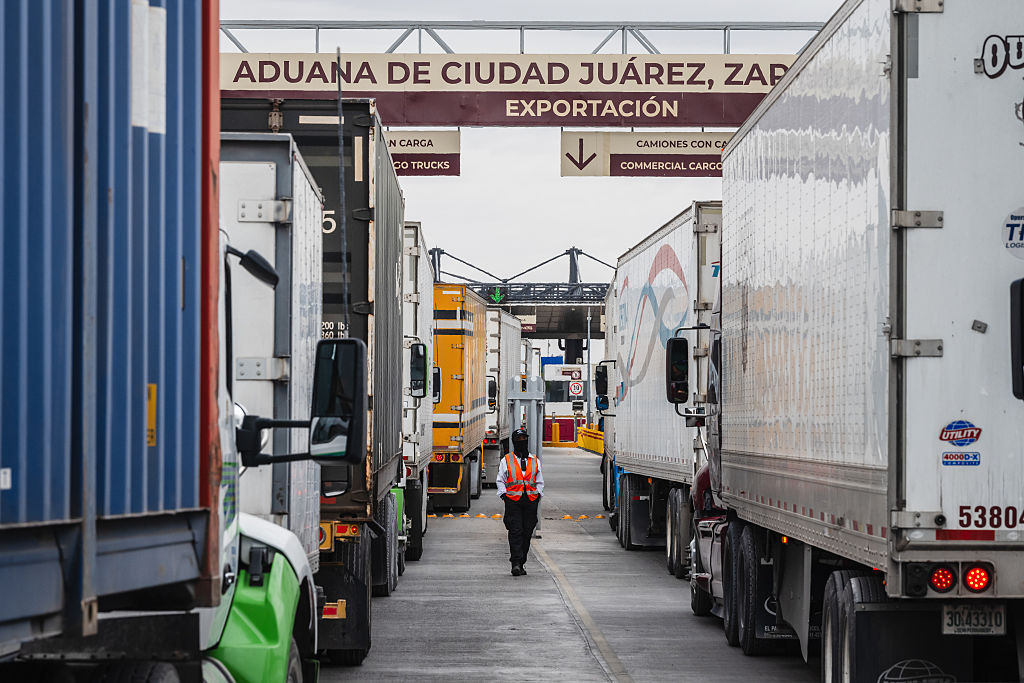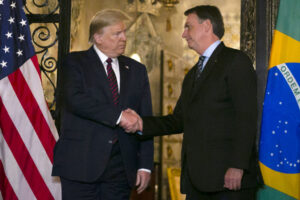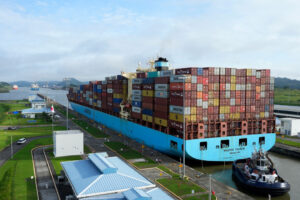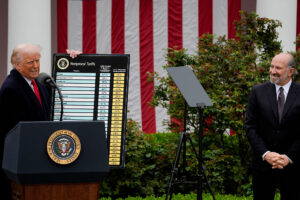
On July 12, President Donald Trump announced 30% tariffs on imports from Mexico would take effect on August 1. In a letter to Mexican President Claudia Sheinbaum that Trump posted on social media, he wrote that the levies would be imposed because Mexico’s actions to stop cartel drug trafficking and secure the U.S.-Mexico border have been “not enough.”
In response, Sheinbaum said she believed Mexico would be able to negotiate “better conditions” and reach a deal before August 1.
Trump’s letter states that the new blanket 30% tariff would be separate from “all Sectoral Tariffs,” meaning that car and other imports with pre-existing tariffs might be exempt from the new measure. It also remains unclear at the time of publish whether the new tariffs would apply to goods covered by the USMCA trade agreement signed during Trump’s previous term as president. Trump additionally wrote that any retaliatory tariffs would trigger even higher levies from the U.S.
AQ asked analysts to share their reactions and perspectives.

Antonio Ortiz-Mena
CEO of AOM Advisors, Adjunct Professor of International Economic Relations at Georgetown University’s Walsh School of Foreign Service, and Chair of the Mexican Foreign Trade Council (COMCE)‘s USMCA Committee
President Trump’s proposal to raise tariffs on Mexican exports to 30% revives important questions about North America’s economic integration and the tools the U.S. uses to advance its goals.
While the motivations—combating fentanyl trafficking and addressing trade imbalances—reflect real concerns, this approach risks weakening regional prosperity and cooperation at a time when both are urgently needed.
Fentanyl poses a devastating threat to U.S. communities. The Trump administration is right to prioritize it. But public health and security experts agree: The crisis has roots on both sides of the border. Effective solutions must address both supply and demand —combining disruption of trafficking networks with expanded access to treatment and prevention.
Using trade as leverage could undermine the trust required to address this transnational challenge. A more strategic path would reinforce joint trade and security ties to build trust and deliver shared results.
If the 30% tariff follows the current 25% model—applying only to non-USMCA-compliant goods—its scope may be limited. But even targeted measures raise costs and introduce uncertainty, particularly in deeply integrated supply chains such as automotive manufacturing. If applied more broadly, the damage could be far greater.
U.S. farmers might also be at risk. Mexico is a key market for exports like corn, soybeans, and pork. Retaliation or diversification toward suppliers like Brazil or Argentina could lead to lasting losses for American producers.
Meanwhile, the push for “90 trade agreements in 90 days” sends mixed signals when paired with new tariff threats. Investment depends on predictability, and this approach could erode business confidence.
The USMCA provides mechanisms for consultation, cooperation, and enforceable dispute resolution. Using this framework for trade disagreements—while pursuing separate channels to address fentanyl—would bolster regional stability and long-term investment. In a time of global uncertainty, North America’s strength lies in unity. Sustainable solutions depend on partnerships.

Ernesto Revilla
Managing director and head of Latin American economics at Citigroup
On Saturday, July 12th, President Trump raised the ‘fentanyl-related’ tariffs toward Mexico from 25% to 30%. The letter was vague on whether this level of tariff applies only to non-USMCA-compliant trade, as the previous 25% tariff did. However, given that Canada received a similar letter (albeit with a 35% tariff), and a U.S. administration official said the expectation was that a USMCA exception would continue to hold, the same may apply to Mexico.
The market so far has interpreted that the new tariff on Mexico represents only a marginal change from the status quo. That is, it is a five-percentage-point increase in a tariff that applies to the less than 20% of total trade between Mexico and the U.S. that is non-USMCA compliant.
More importantly, several elements reduce the expected impact for Mexico. First, we have been here before. President Trump’s aggressive negotiating postures are rarely permanent. The letter explicitly states that if Mexico is successful “in challenging the cartels and stopping the flow of fentanyl,” an adjustment will be considered. Continued cooperation should suffice.
Secondly, the Sheinbaum administration has been markedly more receptive to U.S. concerns than its predecessor—a shift that U.S. officials have acknowledged.
Third—and most crucially—the underlying economics favor continued integration. The U.S. economy is operating at full employment and lacks the capacity to replace imports from Mexico (or elsewhere). A tightening labor market, exacerbated by deportations of undocumented workers, and significantly higher U.S. labor costs mean that reshoring remains largely theoretical. The U.S.-Mexico trade relationship is too entrenched to unravel. Markets seem to agree: The Mexican peso barely flinched.
In another time, such a letter from Washington would have been a cause for grave concern and financial volatility. That today it does not is telling. It is taken as just another step in what promises to be a long negotiation towards the reconfiguration of global trade that the U.S. seeks. When most of the economies around the world, big and small, advanced and emerging, are on the receiving end of similar treatment, what matters is the relative position of each with respect to its U.S. relationship, and the strength of their domestic fundamentals. On both dimensions Mexico remains good, for now.

Heidi Jane Smith
Research professor of economics at Universidad Iberoamericana, Mexico City
Trump’s latest announcement of a 30% tariff on goods and services from Mexico and the European Union signals a further shift in how his administration approaches global trade—rewriting the rules in favor of protectionism. However, there’s a notable difference this time: They’re moving more cautiously to avoid spooking financial markets. Rather than leading a “race to the top,” where favorable terms are extended to allies, this is a “race to the bottom” approach, where exceptions—not rules—define trade policy. Under Trump, protectionist gains are achieved by carving out deals for politically strategic sectors and industries, especially those seen as core to the administration’s voter base. The previous administration’s use of exceptions far exceeded the norm, and analyzing those legal and procedural loopholes is more revealing than simply comparing tariff rates by country.
Mexico, in this context, needs to play it cool. President Claudia Sheinbaum has done well so far by not engaging in direct confrontation, and she should stay the course. This is a David vs. Goliath situation—without even a slingshot. Mexico must gradually seek to diversify its trade relationships, though realistically, building new partnerships will take at least a decade.
Meanwhile, Mexico continues to take hits—some self-inflicted, like the mismanagement of agricultural issues such as the screwworm outbreak. And despite having heavily cooperated with the U.S. in reducing migration flows—a political priority for Trump—Mexico sees little recognition. On other issues like drug trafficking, the challenge remains systemic and unmanageable through enforcement alone. The demand for drugs comes from the North; it’s a gravitational pull that policing alone cannot reverse.
If Trump follows through on the 30% tariff hike, it should be seen from two angles. First, it’s a clear piece of electoral propaganda aimed at energizing his base. Second, as sociologist Ian Bremmer might frame it, it could reflect the early stages of great power retreat. Just as Britain pulled back after World War II, so too might the U.S.—its role as global enforcer, exemplified by naval dominance in places like the Mediterranean, is yielding diminishing returns. Increasingly, the benefits of globalization accrue not to Washington, but to Beijing.

Diego Marroquín Bitar
Adjunct fellow at the Center for Strategic and International Studies
It should not surprise anyone that the self-imposed 90-day deadline to secure 90 new trade agreements came and went with limited results. Only the United Kingdom and Vietnam have agreed to new trade “frameworks” with the U.S. In practice, it takes the Office of the U.S. Trade Representative an average of 917 days to negotiate and conclude a formal trade agreement.
The recent letters threatening further tariffs should be seen not only as a response to this lack of progress but also as part of the administration’s broader strategy to maximize leverage and accelerate commitments on trade, security, and investment.
The consequences of these new tariffs remain uncertain. If they exclude USMCA-compliant goods, their impact may be contained, though implementation costs and loss of competitiveness could still be significant. If they go further, they risk placing additional strain on the long-term durability of the USMCA. So far, President Sheinbaum has successfully de-escalated tensions through swift diplomatic engagement and enforcement actions on migration and narcotics. But it remains to be seen whether Mexico’s strategy of alignment with the U.S. will hold if threats and unilateral measures persist.
Shifting deadlines, unclear benchmarks, and intensifying pressure from Washington come at a cost. If this pattern continues, frustration may give way to quiet disengagement and the gradual rewiring of global supply chains. As important as the U.S. market remains, world leaders may begin to question whether the volatility and political cost of staying aligned with Washington is ultimately worth the effort.
That recalibration could carry long-term consequences. According to Pew Research, 70% of Mexicans and 60% of Canadians now view the U.S. as their main threat. By contrast, just 5% of Mexicans and 15% of Brazilians say the same of China. In this context, even if China is far from an ideal partner, persistent U.S. unpredictability may gradually make it appear more reliable at the expense of American leadership in the region and beyond. There is still time to change course.







